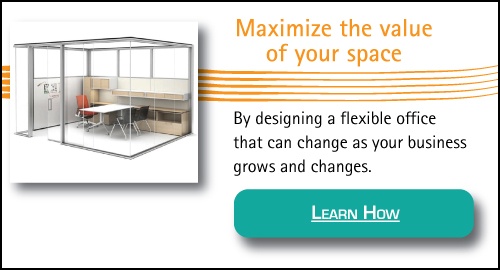From ultra-lightweight workstations to heavy, traditionally built wall partitions, there is no shortage of options for organizing a workspace to fit its employees’ needs.
Changes in the way your workplace is organized can have a significant effect on your employees’ overall productivity. For instance, employee spillover – the tendency for an employee’s nearest neighbours to influence his or her productivity and job satisfaction – can either boost or cut productivity by 15 percent.
Optimizing the physical layout of your office requires that your floor plan matches the type of work each employee performs – from private and quiet spaces for focused or confidential work to open and accessible spaces for creative or collaborative work.
But reconfiguring an office layout traditionally takes a lot of time, energy, and money.
What Are Moveable Walls?
Enter moveable walls. Also referred to as modular walls, moveable walls represent a flexible, cost-effective solution to designing a workplace that can adapt and grow along with your organization.
There are multiple types of moveable wall systems, from modular walls to demountable systems that require a more specialized approach to changing office layouts. Some of the more complex options offer increased acoustic isolation and other benefits, but the underlying concept remains the same; moveable walls can be quickly disassembled, reconfigured or moved and reassembled with little labour and virtually no waste.
Reconfiguring moveable wall systems produces no gypsum dust, little noise and can be done in a fraction of the time compared to a traditional drywall project. Instead of spending days coping with messy, noisy drywall installation, moveable walls allow office layout changes to take place while daily work routines continue as planned.
With moveable walls, project-based office layouts are possible. Your office is able to flexibly cope with evolving business demands by changing its interior structure. In addition, you can more easily incorporate other elements of office infrastructure – like HVAC or electrical and data cabling – without having to risk implementing expensive changes later on.
And if you are not sure your office will remain in the same building, you have an even greater incentive to look towards moveable walls. Upon moving out, you can pack up your moveable wall system and take it with you.
The Benefits of Using Moveable Walls
There are a variety of benefits to using moveable walls: they produce less waste than drywall, they reduce the cost to change your space as you need to, they are mess-free to reconfigure and they allow you to maximize the value of your space. Let’s look at the two that we find resonate most with our customers, reducing the cost of change and giving you the ability to use your space more efficiently.
Moveable Walls Reduce the Cost of Change
Modular wall systems reduce the cost of moving and adjusting office interior walls. The ability to quickly construct new layouts without relying on messy, inefficient drywall installation projects makes workplace optimization much less costly.
For instance, although the average cost of installing drywall is low, once you include the cost of knocking down old walls and framing, taping, and mudding for drywall installation, you can easily reach $6 or $8 per square foot. The fact that moveable walls have the electrical and data cabling built saves even more time and expense by eliminating the need to rewire the reconfigured space.
To top it all off, if you rent the office, you need the owner’s permission to make these changes, and if you eventually move out of that building, the investment is lost.
The growing trend of incorporating full-glass walls into private offices and meeting areas only further reaffirms this point. Ever tried to move a glass wall eight feet to the right so that your large boardroom can be better used as two smaller meeting spaces? I don’t recommend it.
If you are using a moveable wall system, however, the glass panels can simply be detached from their neighbouring panels and reattached in the new location.
As floor-to-ceiling glass moveable walls have grown in popularity their cost has also decreased significantly. It can actually cost less to use glass moveable walls than a standard panel moveable wall and if you are comparing traditionally constructed glass walls to glass moveable walls you will significantly reduce your installed cost by opting for moveable walls.
This means that for astute office managers, the primary cost consideration is between moveable walls vs. drywall. In the vast majority of cases, moveable wall systems offer greater flexibility and better long-term value than drywall installation.
Use Office Space More Efficiently with Moveable Walls
Employee flux is real, as individual workers move up the corporate ladder or change departments or locations. If you invest in the separation of a large room into two smaller rooms to make space for an employee only to discover that, a few years later, that employee no longer works for you, will you still be paying rent for space that you aren’t using?
Or perhaps the opposite situation rings more true for your business. Your team is growing and you need to fit more workstations into your existing space. Will you be able to reconfigure or convert some of those private offices and meeting rooms around the exterior of your space to multi-user workstation layouts or will you need to lease additional space elsewhere?
Most managers will hold onto the existing configuration until they absolutely need to change it in order to avoid the cost, and hassle, of knocking down and reinstalling drywall, painting and rewiring the electrical and data. That leads to inefficient use of office space, as every unoccupied square foot costs money – with average net rates of between $12 and $18 in Halifax. All the while their team is working in a floorplan that isn’t designed to meet their current requirements, which can have a pronounced effect on daily productivity.
With a moveable wall system, you can immediately change the layout of an office in response to new business demands. Large meeting rooms – often the least efficiently used rooms in the office environment – can be separated into multiple smaller rooms to accommodate more workstations or multiple meeting spaces.
Are Moveable Walls Worth Buying?
Without understanding your businesses exact needs and requirements we cannot give you a definitive answer, but we can tell you this… we recommend that almost all of our customers buy moveable walls when moving into a new office space or renovating their current space. It may not make financial sense to replace your existing drywall partitions but when you have a blank slate to start from, we have not had a single customer regret investing in the flexibility of moveable walls.
Now that you know you want to invest in moveable walls for your new office space, are you wondering just how much you are going to need to invest? Our article on the Cost of Moveable Walls not only gives you a budget to target but breaks down what impacts your final price.
Cory Porteous
Director of Marketing & Inbound Business Development
Office Interiors





